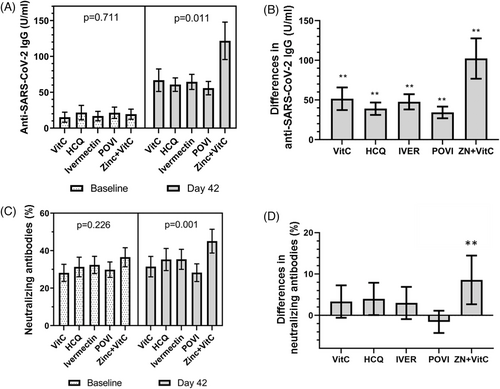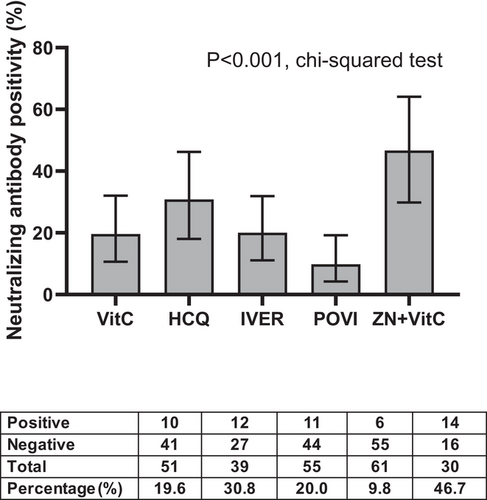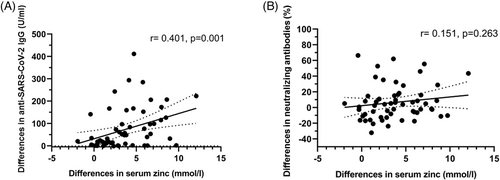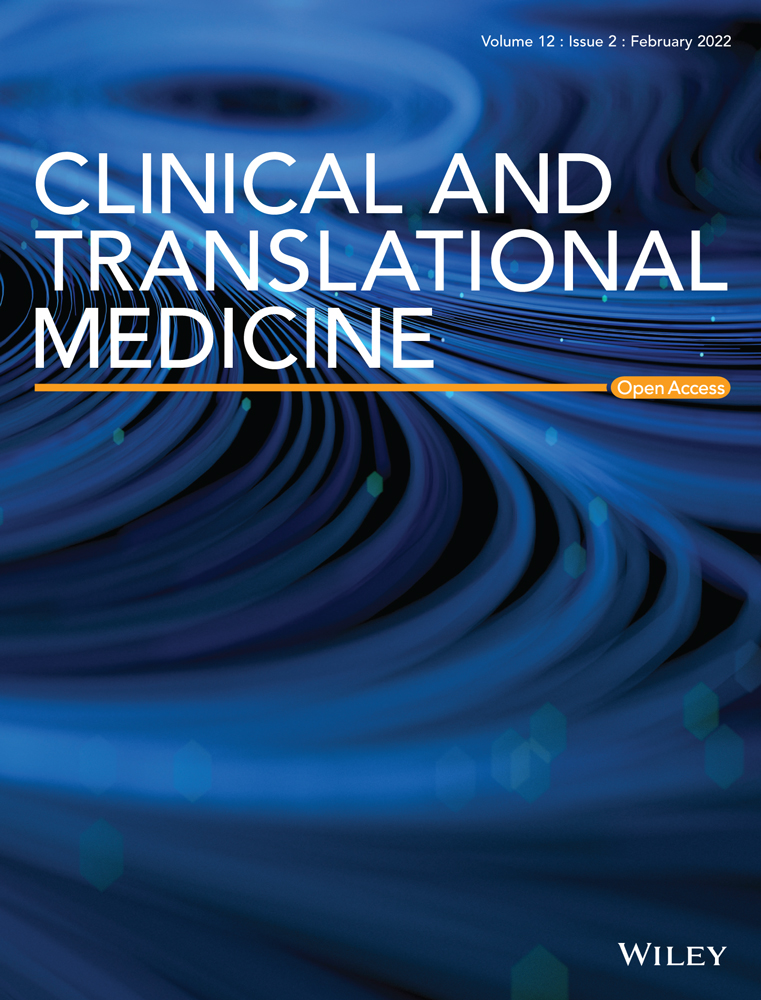Zinc and vitamin C intake increases spike and neutralising antibody production following SARS-CoV-2 infection
ClinicalTrials.gov number: NCT04446104
Previous studies have not examined whether pharmacologic interventions could increase SARS-CoV-2 antibody responses. Certain medications (e.g. zinc and vitamin C) are known to stimulate immunologic responses following infections.1, 2 Zinc exerts pluripotent effects on the immune system and supports the integrity of the epithelial cell barriers,1, 3 while vitamin C is an antioxidant that potentially protects against viral respiratory infections.2 Hydroxychloroquine and ivermectin are anti-parasitic medications that are known to modulate innate and adaptive immunity.4, 5 By contrast, povidone-iodine is a topical broad spectrum antiseptic capable of direct virucidal effects.6 We hypothesise that interventions that support immune regulatory functions could enhance production of anti-SARS-CoV-2 spike and neutralising antibodies among individuals with prior infection. Using materials and resources of the DORM trial (NCT04446104),7 we compared the antibody responses at baseline and on day 42 among seropositive participants who received the different medications as part of this trial.
Participants from the study were selected from the DORM trial, an open label, randomised clinical trial that examined the efficacy of either oral hydroxychloroquine (400 mg followed by 200 mg/day), povidone-iodine throat spray (three times a day, approximately 270 μg/day), oral ivermectin (12 mg, single dose), oral zinc + vitamin C (80 mg zinc sulfate, 500 mg vitamin C/day) or oral vitamin C (500 mg/day), for 42 days to reduce SARS-CoV-2 infection (Supporting Information).7 From 4257 recruited participants, those found with new SARS-CoV-2 infection on recruitment were enrolled into the present substudy.
Antibody titers were measured using two different assays that quantified binding (Elecsys®, Roche, Germany) and neutralising antibodies (cPass™, GenScript, USA) targeting the SARS-CoV-2 spike antigens. To examine the impact of different interventions on the immune cells, the frequency of B and T lymphocytes was analysed using pre-formulated DURAClone IM Phenotyping Basic and B Cell Panels (Beckman, USA). Serum zinc was measured in zinc-treated participants using an inductively coupled plasma mass spectrometry method (PerkinElmer, USA). SPSS Statistics version 27 (IBM Corporation, Armonk, USA) was used for all analysis (Supporting Information).
A total of 422 men were enrolled, from among 478 seropositive cases in the DORM trial; those excluded either withdrew from the study (n = 22) or did not return for follow-up visit (n = 24) (Figure S1). The primary cohort comprised 422 men (mean age, 33.0 years; standard deviation (SD), 7.3 years) who received zinc + vitamin C (n = 68), hydroxychloroquine (n = 67), ivermectin (n = 99), povidone-iodine (n = 107) and vitamin C (n = 81) (Table 1, Figure S1). Few had medical co-morbidities (hypertension, 1.4%; diabetes mellitus, 0.7%; hyperlipidemia, 0.2%). Overall, anti-SARS-CoV-2 spike antibody positivity increased from baseline level of 80% to 94% by day 42, whereas neutralising antibody positivity increased from 44% to 49% by day 42.
| Zinc + vitamin C (n = 68) | Hydroxychloroquine (n = 67) | Ivermectin (n = 99) | Povidone-iodine (n = 107) | Vitamin C (n = 81) | |
|---|---|---|---|---|---|
| Participant characteristics | |||||
| Age (years), mean (SD) | 33.2 (7.8) | 30.6 (6.4) | 33.6 (6.9) | 32.0 (6.6) | 32.9 (7.1) |
| Country of origin | |||||
| Bangladesh | 36 (52.9%) | 28 (41.8%) | 46 (46.5%) | 52 (48.6%) | 40 (49.4%) |
| India | 32 (47.1%) | 38 (56.7%) | 51 (51.5%) | 55 (51.4%) | 41 (50.6%) |
| Others | 0 | 1 (1.5%) | 2 (2.0%) | 0 | 0 |
| Medical history | |||||
| Hypertension | 1 (1.5%) | 1 (1.5%) | 3 (3.1%) | 1 (0.9%) | 0 |
| Diabetes mellitus | 1 (1.5%) | 0 | 1 (1.0%) | 0 | 1 (1.3%) |
| Hyperlipidemia | 0 | 0 | 1 (1.0%) | 0 | 0 |
| Baseline parameters | |||||
| Systolic BP (mmHg) | 136.6 (15.9) | 127.4 (11.6) | 135.7 (15.1) | 134.4 (17.7) | 133.8 (17.5) |
| Diastolic BP (mmHg) | 86.6 (11.6) | 81.2 (6.4) | 89.8 (9.3) | 86.6 (11.6) | 88.5 (10.9) |
| Pulse rate (per min)a | 97.4 (15.5) | 86.9 (7.9) | 96.9 (13.4) | 93.3 (11.8) | 97.1 (13.9) |
| Body mass index (kg/m2) | 24.34 (3.43) | 24.36 (3.44) | 25.73 (2.72) | 24.62 (3.55) | 24.19 (3.02) |
- aResting heart rate.
Anti-SARS-CoV-2 immunoglobulin G (IgG) levels, which were comparable at baseline, increased substantially by day 42, especially in the zinc + vitamin C group compared with other interventions (Figure 1A,B). By contrast, an increase in neutralising antibodies (measured by percent inhibition of surrogate virus neutralisation tests) was confined to the zinc + vitamin C group by day 42 (Figure 1C,D). Among seropositive men without neutralising antibodies at study entry, conversion to neutralising antibody positivity was highest in the zinc + vitamin C group (46.7%) by day 42, compared with vitamin C (19.6%), hydroxychloroquine (30.8%), ivermectin (20%) and povidone-iodine (9.8%) (p < .001, chi-squared test) (Figure 2). Overall, seropositive men who were initially negative for neutralising antibodies were approximately four times more likely to develop neutralising antibody positivity by day 42 in the zinc + vitamin C group compared with other interventions (odds ratio (OR) 3.75, 95% confidence interval (CI) 1.69–8.32). To further investigate the primary findings, zinc was measured in baseline and day 42 sera of men who received zinc + vitamin C. As expected, serum zinc rose from a baseline mean of 14.0 mmol/l (SD 1.9) to 17.8 mmol/l (SD 2.5) by day 42. The extent of rise in serum zinc from baseline to day 42 correlated significantly with anti-SARS-CoV-2 spike IgG (r = 0.401, p = .001) (Figure 3A), but not with neutralising antibodies (Figure 3B).



To examine the impact of the different interventions on immune cell populations, immunophenotyping was performed on whole blood in 211 participants (Figure S2). Compared with other interventions, zinc + vitamin C-treated men had a higher percentage of transitional B cells (mean 3.49% vs. 2.54%, p < .001) (Table S1). No statistically significant differences were observed with isotype class switch, marginal zone, naïve and plasmablast B cells, CD4+ T cells, CD8+ T cells, natural killer cells, classical, intermediate and non-classical monocytes. In this cohort, transitional B cells were weakly correlated with neutralising antibodies (r = 0.192, p = .005) (Figure S3A). Among men who were initially negative for neutralising antibodies, an increase in double-negative T cells frequency was observed among those with seroconversion in neutralising antibodies by day 42 (mean 8.40% vs. 5.92%, p = .004) (Table S2). A weak but statistically significant association was observed between double-negative T cells and neutralising antibodies by day 42 (r = 0.272, p = .004) (Figure S3B).
Findings from this study highlight suboptimal production of neutralising antibodies in more than 50% of individuals following an asymptomatic infection. Compared with other interventions, those who received zinc + vitamin C were found to subsequently mount a greater antibody response. Among individuals who were initially seronegative to neutralising antibodies at study entry, conversion to positivity was approximately four times higher among zinc-treated men compared with those who received other interventions. By activating innate and adaptive B and T cellular responses, the immune system produces binding antibodies especially against the nucleocapsid and spike proteins of the SARS-CoV-2 virus, and neutralising antibodies to aid immunity.8, 9 We observed significant alterations in early transitional B cells but not in B cell populations at later stages of maturation. The significance of increase in double-negative T cells among neutralising antibody seroconverters is unclear. Among hospitalised patients, those with a higher double-negative T cells to surface expression of CD4 and CD8, tended to have a milder disease with fewer requiring oxygen and ventilatory support,10 suggesting double-negative T cells could be beneficial during SARS-CoV-2 infection.
To our knowledge, this study is the first to demonstrate the efficacy of oral zinc + vitamin C treatment to stimulate antibody production following SARS-CoV-2 infection. Future studies should examine whether increase in antibody production following zinc + vitamin C could sustain immunity against re-infection, and enhance antibody responses following vaccination among immunocompromised individuals. Results from this study should be confirmed in prospectively designed studies.
ACKNOWLEDGEMENTS
The authors are indebted to our participants, volunteers, sponsors, operations team at Tuas South Dormitory, Tissue Repository Unit at the National University Hospital (NUH), NUH Research Office, Dean's Office at the Yong Loo Lin School of Medicine and Beckman Coulter for their generous support. We are grateful to the National Medical Research Council (COVID19RF2-0052, CSA-SI/0003/2015), Temasek Foundation—Singapore Millennium Foundation (SMF), and National University Hospital Research Office (NUHSRO/2020/069) for their generous support. Our sponsors had no input in the study design, analysis of results and report of study findings.
CONFLICTS OF INTEREST
Dr. Seet reported receiving grants from the National Medical Research Council and Temasek Foundation, Singapore. Dr. Tambyah reported receiving grants from Johnson and Johnson, GlaxoSmithKline and Roche.




